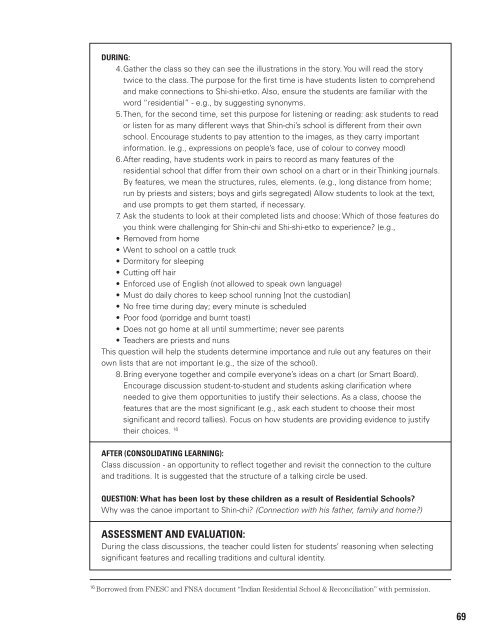Residential Residential
Residential_School
Residential_School
Create successful ePaper yourself
Turn your PDF publications into a flip-book with our unique Google optimized e-Paper software.
DURING:<br />
4. Gather the class so they can see the illustrations in the story. You will read the story<br />
twice to the class. The purpose for the first time is have students listen to comprehend<br />
and make connections to Shi-shi-etko. Also, ensure the students are familiar with the<br />
word “residential” - e.g., by suggesting synonyms.<br />
5. Then, for the second time, set this purpose for listening or reading: ask students to read<br />
or listen for as many different ways that Shin-chi’s school is different from their own<br />
school. Encourage students to pay attention to the images, as they carry important<br />
information. (e.g., expressions on people’s face, use of colour to convey mood)<br />
6. After reading, have students work in pairs to record as many features of the<br />
residential school that differ from their own school on a chart or in their Thinking journals.<br />
By features, we mean the structures, rules, elements. (e.g., long distance from home;<br />
run by priests and sisters; boys and girls segregated) Allow students to look at the text,<br />
and use prompts to get them started, if necessary.<br />
7. Ask the students to look at their completed lists and choose: Which of those features do<br />
you think were challenging for Shin-chi and Shi-shi-etko to experience? (e.g.,<br />
• Removed from home<br />
• Went to school on a cattle truck<br />
• Dormitory for sleeping<br />
• Cutting off hair<br />
• Enforced use of English (not allowed to speak own language)<br />
• Must do daily chores to keep school running [not the custodian]<br />
• No free time during day; every minute is scheduled<br />
• Poor food (porridge and burnt toast)<br />
• Does not go home at all until summertime; never see parents<br />
• Teachers are priests and nuns<br />
This question will help the students determine importance and rule out any features on their<br />
own lists that are not important (e.g., the size of the school).<br />
8. Bring everyone together and compile everyone’s ideas on a chart (or Smart Board).<br />
Encourage discussion student-to-student and students asking clarification where<br />
needed to give them opportunities to justify their selections. As a class, choose the<br />
features that are the most significant (e.g., ask each student to choose their most<br />
significant and record tallies). Focus on how students are providing evidence to justify<br />
their choices. 16<br />
AFTER (CONSOLIDATING LEARNING):<br />
Class discussion - an opportunity to reflect together and revisit the connection to the culture<br />
and traditions. It is suggested that the structure of a talking circle be used.<br />
QUESTION: What has been lost by these children as a result of <strong>Residential</strong> Schools?<br />
Why was the canoe important to Shin-chi? (Connection with his father, family and home?)<br />
ASSESSMENT AND EVALUATION:<br />
During the class discussions, the teacher could listen for students’ reasoning when selecting<br />
significant features and recalling traditions and cultural identity.<br />
16<br />
Borrowed from FNESC and FNSA document “Indian <strong>Residential</strong> School & Reconciliation” with permission.<br />
69


